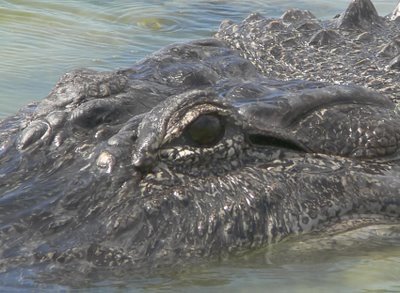
The cormorants were closer at hand, all engaged in active gular flutter in the heat. It looks like panting, but is actually a rapid forcing of air in and out of the mouth, so as to flutter the cheeks, or the bird equivalent of cheeks. The _Online Birds of North America_ says that it cools adult cormorants effectively, though young birds have to stay in the shade or die. I would have tried to use the video function of the camera to capture the fluttering movement, but I was hoarding camera memory for a multi-day trip. So at best you might detect a slight throat blur in the still photo.

Shortly after I took the previous photos, a large alligator, about 9 or 10 feet long, came swimming--very slowly, as alligators do--out of the marsh up to the place where I was standing with several other birdwatchers, a bird observation walkway that extends out into the cattails. The alligator gazed at us with interest, but we were out of reach. Alligators have large eyes. I had for some reason assumed they did not see well, but obviously they do. Here's a close-up of an alligator eye looking at the photographer.

Finally, here's a willet on the beach.

(click photos to enlarge)
Addendum: In response to a comment, here is an additional photo to clarify which way the alligator above is facing.

No comments:
Post a Comment